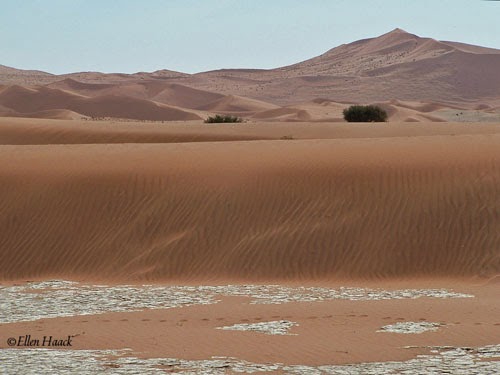Etosha National Park, continued
We were impressed by the ease of driving through Etosha National Park to see the wildlife. We were even more impressed to find that the rest camps, as they are called, were sited adjacent to waterholes. It was a short walk from our little chalet at the Okaukuejo Rest Camp to sit, relax and watch the animals come to the waterhole at sunset or sunrise.
 |
| The Okaukuejo Rest Camp was adjacent to this waterhole. Note the stone and fence barricade. If the blog photo were higher resolution, you could see others seated, as we were, to watch the animals. |
 |
| Oryx (gemsbok) cooled themselves in the waterhole at sunset. (Though difficult to see, there’s a jackal near the water at center-right.) |
 |
| Sunset also brought giraffe and many other animals. |
Namib-Naukluft National Park
From Etosha National Park, we drove southwest about 310 miles to Swakopmund, a town on the Atlantic coast at the northwest corner of the Namib-Naukluft National Park. Although this park, at over 19,200 square miles, is the largest nature reserve in Africa, it’s more famous for its landscapes-- Namib Desert sand dunes, Naukluft mountain range--than its wildlife.
The desert does indeed meet the ocean in and to the south of Swakopmund. We, however, viewed this unique junction through fog and mist, which we were told is nearly perpetual. From Swakopmund, we went on a guided “Mountains of the Moon - Welwitschia Tour” that took us about an hour inland.
 |
| Our tour van and a view of the lunar-like landscape. |
 |
| Sossusvlei Lodge, a privately-owned, upscale tented camp, outside the gates to the Namib-Naukluft National Park. |
 |
| Sossusvlei sand dunes from afar. |
 |
| Sossusvlei’s enormous sand dunes, gorgeous against the bright blue sky. |
 |
| Walking on the Sossusvlei dunes is permitted though not easy, and there were people ascending at various heights at this location. |
 |
| We visited the Sossusvlei area of the park for the dunes but also found Oryx. |
 |
| Some unusual dune features. |
After Sossusvlei, we made a hurried drive--well, as hurried as it could be over the many gravel stretches--225 miles northeast back to Windhoek to catch our flight home carrying many wonderful memories with us.
 |
| As the rhinos wistfully left the Etosha Park waterhole, we wistfully said goodbye to Namibia. |
I hope you enjoyed this brief tour of Namibia’s national parks and that you’ll join me in thanking Ellen and Barry Haack for taking us along. Thanks for stopping by.


No comments:
Post a Comment